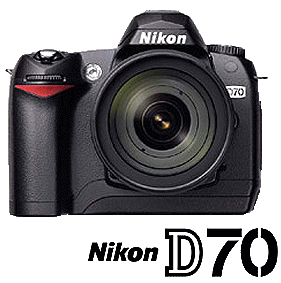by Jim McGee
 Two
months ago in issue #30 we
ran an article titled This
One Changes Everything: Canon's New Rebel The First Digital SLR Under
$1,000.
Two
months ago in issue #30 we
ran an article titled This
One Changes Everything: Canon's New Rebel The First Digital SLR Under
$1,000.
Two months later I'm prepared to say that it has done just that.
Nikon just announced its new digital SLR - the D70. The press release is quite vague and there are few hard details beyond the photo of the camera that you see here, that it will be available in the spring and that the camera will retail for around $999.
 |
|
Nikon's answer to the Digital Rebel is the $999 D70 scheduled for a spring release. |
The fuzzy nature of the press release and the timing have led to a lot of speculation that Nikon is scrambling to get something out there to compete with the Digital Rebel - even if that something is just the promise of a comparable Nikon. That might be enough to keep current Nikon users from jumping brands. The Digital Rebel is after all, selling like hot cakes.
Reading Between the Lines
It would be a fair guess that the D70 will be based around the D100
imaging hardware/firmware, but that the D70 will probably lack some of the
D100's ruggedness. The D70 will be compatible with all current F-mount
autofocus and DX lenses.
Like the Digital Rebel the D70 will likely be more of a consumer camera and just as the Digital Rebel lacks features of the Canon 10D the D70 will likely lack some of the features of the D100. I'd expect the details of the D70 to be announced at PMA in mid-February. Nikon says the camera will be available in the spring so expect to see it in early summer.
Why is this so important?
The emergence of these cameras signals two significant changes in the Digital SLR arena.
1. They're becoming affordable
2. We've entered a new stage in digital photography where the cameras will be judged on features and price points - not just megapixels.
Affordable?
When I refer to $899 or $999 as affordable there will inevitably be a
round of email from readers choking on the price and questioning my
sanity. After all a Canon Rebel Ti sells for around $225 and a Nikon N75
is around $230. How could digital be considered affordable when you're
getting essentially the same camera but paying four times as much for the
digital format?
I'm not going to open the whole digital vs. film debate in this column; nor will I debate whether the recurring costs of digital are really cheaper than the recurring costs of film (also see Digital's Dirty Little Secret) . Suffice it to say $900 is cheap for a digital SLR; and judging by Digital Rebel sales a lot of people agree with me.
Growing Up
Digital has had to get over quite a few hurdles to get to where it is
today. Early cameras were expensive, had low resolutions and marginal
image quality. If you still have an old Nikon catalog or some old Canon
brochures drag them out and look at just how bad they really were.
Think I'm exaggerating? The 1996-97 Nikon catalog talked about the new E2N "...there's no more compelling investment". This was a 1.3 megapixel (1280x1000) camera capable of taking a 15MB PC card, weighing over 4 pounds that cost a whopping $9,995. It's a wonder they ever sold any!
Once resolutions became respectable there were the inevitable comparisons to film. Could you capture images that rivaled film for quality with a digital camera? That question has now been answered absolutely. You can.
The next big hurdle is making digital affordable. Let's face it, there are a lot of photographers out there who simply can't even consider the $3,500 to $4,000 it takes to get into a high end digital body. Even $1,400 is on the high end of the comfort scale.
But as one marketing exec confided at PMA last year:
"There are two price points we're looking at, $1,000 and $700. At each of those price points you bring in significant numbers of (digital SLR) buyers."
"At $400 you open a flood gate."
What he's saying is there is a point where digital SLRs become a commodity just as their film cousins have. At that point buyers are no longer making buying decisions based on megapixel counts. Now buyers begin to think more like a photographer when choosing a digital SLR. What features does it have? How rugged is it? How many cycles before the shutter fails? Is it weatherproof? And in the case of digital what range of color and light can I capture?
That is a huge shift in the mechanics of the digital SLR marketplace.
The $400 Digital Rebel
So how far away is the $400 or even $200 Digital Rebel?
Obviously the technology isn't there yet. But every year memory and computing power get cheaper and manufacturers have now recouped the development costs on the technology in cameras like the 10D and D100. As new and better technologies emerge for higher end cameras expect to see previous generation technologies trickle down into ever cheaper entry level cameras.
In other words I expect a sub $400 digital SLR will be possible within the next 24 to 36 months.
But from a marketing perspective does it make sense to release such a camera?
If the numbers I've heard are true the size of the market for such a camera is huge.
That means the answer is yes.
| Digital SLR Street Prices | ||
| Camera | Megapixels | Price |
| Canon 1Ds | 11.1* | $8,000 |
| Canon 1D | 4.1 | $4,000 |
| Canon 10D | 6.3 | $1,500 |
| Canon Digital Rebel | 6.3 | $899 |
| Fujifilm S2 Pro | 6.1 | $2,000 |
| Kodak 14n | 13.8* | $5,000 |
| Nikon D2H | 4.1 | $3,500 |
| Nikon D1X | 5.47 | $3,900 |
| Nikon D1H | 2.74 | $3,200 |
| Nikon D100 | 6.1 | $1,700 |
| Nikon D70** | 6.1*** | $999 |
| Olympus E-1 | 5.0 | $1,800 |
| Pentax *ist | 6.1 | $1,700 |
| Sigma SD-9 | 3.4 | $1,100 |
|
*Full frame imaging
chip |
||

